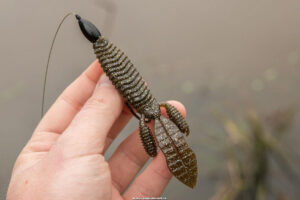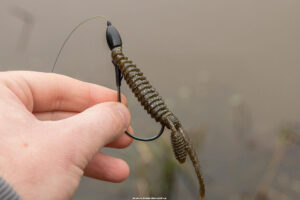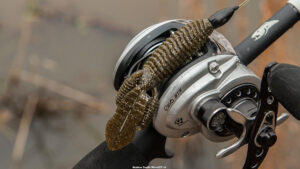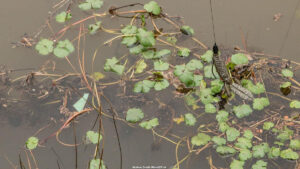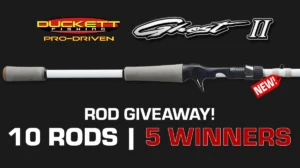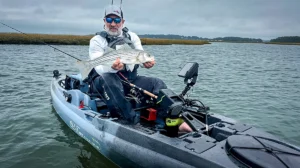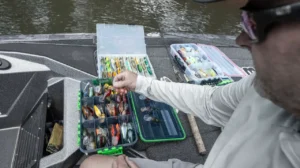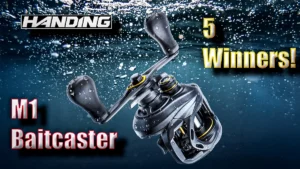I can remember when I first started buying my own fishing tackle as a child. It was really overwhelming—especially when it came to soft plastics. I often found myself buying the craziest shapes I could find because I figured the more wiggly and expensive they were, the more fish they’d catch. Before I knew it, I was one broke, scrawny and frustrated young fisherman.
It’s funny how my experience has changed things, though. I’ve now caught some of my biggest bass on the simplest soft plastic baits you can imagine. If you were to look in my boat these days, you’d probably be surprised by the relative plainness of my soft plastics collection.
I’ve had an opportunity to fish with the Reins Punching Predator for the past several months. It’s not the sexiest-looking bait you’ll find. It doesn’t have a bunch of appendages and it doesn’t come in flashy packaging. But it’s simplistic design incoporates some really interesting design features that make it a legit flipping and pitching bait.
- Soft appendages
- Durable
- Holds a big hook
- Practical color schemes
Lots of action without much movement
There’s just something about an outrageous soft plastic shape that many anglers have a hard time ignoring. I guess it’s like a shiny car or a nice, slick finish on a new bass boat. But there’s not much need for flash when you’re punching, flipping or pitching. You need your bait to penetrate the thick stuff quickly and get bites. That’s it.
The Reins Punching Predator features incredibly soft and pliable appendages— two pincers and two tentacles, as I call them. Nothing too crazy, right? The key ingredient throughout my personal testing, however, has been the attention grabbing, yet subtle action that these appendages produce.
This bait doesn’t put on much of a show as it falls to the bottom, and I’m totally fine with that. Again, it’s designed to get to the strike zone efficiently. But when it’s at rest, it seems to come alive and produce some really nice-looking action. The elongated tentacles stand upward in a defensive posture and sway back and forth with the water’s natural movement. By simply popping the slack in your line, they’ll slightly quiver while the body of the bait remains totally still.
The smaller will also slightly elevate themselves off the bottom, but tend to have a much tighter and more subdued “wobble” to them as you impart action into the bait.
Some might see the lack of appendages and prematurely categorize the Punching Predator as a “do nothing” bait. But its profile and design fit my style of fishing—flipping, pitching and punching the thickest stuff I can find—quite well. It falls straight, which is a huge plus in my opinion. I don’t want a big ol’ soft plastic spiraling to the bottom because that’s often the primary cause of unwanted snags and wasted casts.
It’s pretty darn tough to be so soft
I have to say that I was pleasantly surprised by the durability of the Punching Predator. If you read my reviews often, you’re well aware of my repugnance toward wimpy soft plastics. So when I first took a bait from the package, I wasn’t too excited about it, to be totally honest. It felt very soft, so I incorrectly assumed it would be a “one-and-done” type of bait— catch one fish and throw the remains in the floor of the boat.
As it turns out, however, it held up very well throughout my testing. I’ve caught up to four bass on a single bait, which is asking a lot for a bait of this softness and stature. The pincers and tentatles stay intact fairly well and have proven to be quite resistant to those obnoxious bluegill “pecks” in the warmer months.
This bait is meant for thick cover—get ready for a “duh” moment—so it’s going to spend a lot of time coming into contact with said cover. You’ll crash it into limbs, heavy grass stalks and docks posts throughout a normal day of fishing. And it actually stays rigged quite nicely. I’ve rarely found myself adjusting it between flips and pitches.
Big hooks are no problem
When I’m fishing any type of soft plastic, I try to use the biggest hook I can possibly get away with. A lot of missed opportunities occur when a fish doesn’t fully commit—or inhale—your offering. They’ll often nip at the tail-end of the bait and hesitate before taking that second gulp, which leaves us striking out on the hookset. So to counter this, I want my hook point close to the business end.
The Punching Predator holds a 5/0 flipping hook with no problem whatsoever. The hook point is positioned very closely to the bottom of the bait’s body, giving finicky bass very little room for error. If they try to eat anything above the appendages, they’re going to have a rough day.
Practical colors for close combat
More times than not, I’m fishing thick cover on high sky, bluebird days. The reason is simple—the abundance of sunlight tucks bass into and underneath cover and they become much easier to predict and locate.
On these sunny days, I very rarely use “flat” colors such as green pumpkin or a straight black and blue. Instead, I like to use colors with some sort of metallic flake in them. And it’s getting tough to find such colors. But the Punching Predator comes in some excellent colors for close combat fishing. You’ll notice a lot of silver flake throughout their color schemes, which is a big confidence booster for me.
My favorites are the Green Pumpkin Silver and Green Pumpkin Blue Laminate Silver. Regardless of the water clarity, these two colors will produce some bites.
If you like to pitch, flip and punch, I think the Punching Predator is well worth a look. They may not have all the bells and whistles that we’re so accustomed to seeing, but that’s okay. They’re a legit bait for picking apart heavy cover.
The Reins Punching Predator is available at TackleWarehouse.com.



